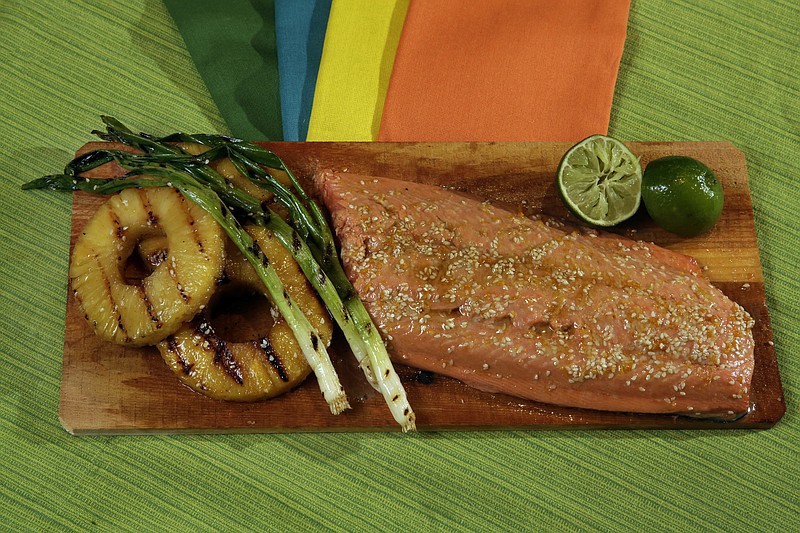As promised, here is the second part of the list of regional superfoods.
6. Berries are loaded with antioxidants and phytonutrients, are low in calories and are high in water content and fiber. They can satisfy sweet cravings for a fraction of the calories. Blueberries and cranberries top my list of favorite berries because of availability (fresh, frozen, dried) and versatility. Raspberries are the highest in fiber, packing 4 grams per cup serving. All berries add flavor and nutrition to numerous dishes from salads and cereals to baked goods and yogurt.
7. Salmon is low in calories and saturated fat, yet high in protein, and omega-3 essential fatty acids. (Essential fatty acids are essential for human health and because they cannot be made by the body, they must be obtained from foods.) Salmon is an excellent source of selenium, a very good source of protein, niacin and vitamin B12, and a good source of phosphorus, magnesium and vitamin B6. The American Heart Association recommends eating fish, especially fatty fish such as salmon, at least twice a week to ensure you get plenty of heart-healthy omega 3 fatty acids. I suggest that you limit farm raised salmon consumption to once a week at most if you are unable to find fresh, wild salmon. In addition, trim the skin and fat as much as possible and use cooking methods such as grilling and boiling to reduce fat, as this is where the toxins are stored. You also may want to try canned salmon, which is much easier to find in the wild form and tends to be less expensive.
8. Pumpkin is chocked full of antioxidants and beta-carotene. Antioxidants help strengthen our immune system. Beta-carotene converts to Vitamin A and helps reduce the risk of cancer and other dangerous diseases. Additionally, because pumpkins have a high water content, they are an ideal choice for a snack because they help to provide a good source of water and are low fat. When using pumpkin in various recipes, be aware that it is usually the addition of eggs that boosts the amount of calories in items such as pumpkin pies or pumpkin breads. To eat pumpkin on its own, try roasting it with spices like cinnamon or nutmeg, or blending pumpkin puree with apple cider for a deliciously healthy drink. Pumpkin seeds are another part of the pumpkin which are also very good for you. Pumpkin seeds contain a large variety of minerals and other vital nutrients, such as iron, protein and fiber. Typically, you can find pumpkin seeds roasted or raw, shelled or unshelled.
9. Leafy Greens, including kale, collard, spinach, turnip and mustard contain a wide array of beneficial substances including proteins, protective phytochemicals and healthy bacteria. The stand outs are jam-packed with vitamins A, C, and K, folate, potassium, magnesium, iron and fiber. Leafy greens tend to be versatile and can be served raw or lightly blanched with a splash of lemon juice or red wine vinegar. They can also be added to soups, casseroles or wraps for an added nutritional punch.
10. Quinoa, pronounced "KEEN-wah" or "kee-NO-wah," is not actually a grain, but is a seed. It can substitute for nearly any grain in cooking and is rich in protein, iron, potassium, magnesium, fiber, phytonutrients and antioxidants. Be sure to rinse, strain and soak before cooking as needed. When cooking, use one part quinoa to two parts liquids. Plain water works fine, but I like experimenting with various broths or stocks for extra low-calorie flavoring. Place both the quinoa and the liquid in a saucepan, and bring it to a boil. Reduce the heat to a simmer, cover and let the seeds cook for 10 to 15 minutes - or until the water is absorbed, the seed is translucent and the germ is partially detached (it will look like a little feather or spiral). When cooked, quinoa has a crunchy, nutty flavor. It works great in savory side salads, mixed into veggie burgers and more. I also enjoy it as a hot breakfast cereal - just pour in milk of choice and add chopped nuts for that satisfying crunch.
There you have it, this RD's partial list of so called super foods. Remember, the most important aspect related to good health is a dietary pattern that includes a wide variety of nutritious foods and regular physical activity. I hope you enjoy the recipe shared this month I am also hoping for better weather, hence incorporating the word "summer" into the title bodes well with me. Go out and enjoy a nice walk while your salmon and quinoa are cooking and be well.
Denise Coots, RD, LD, CNSC is the clinical nutrition coordinator at SSM Health, St. Mary's hospital in Jefferson City. She has a passion for helping others ranging from those patients in the intensive care unit to individuals in the community with various dietary issues.


